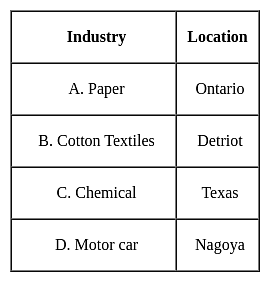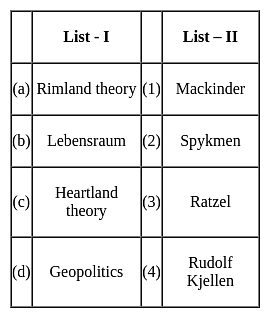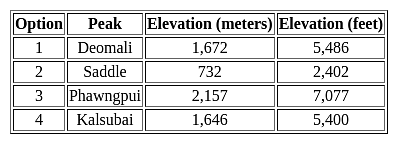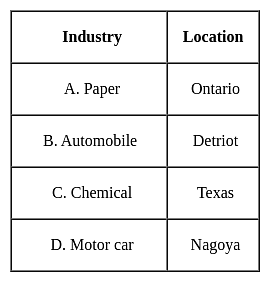UGC NET Paper 2 Geography Mock Test - 4 - UGC NET MCQ
30 Questions MCQ Test UGC NET Mock Test Series 2024 - UGC NET Paper 2 Geography Mock Test - 4
Which among the following is the highest peak of Andaman and Nicobar Islands?
A narrow passage of water connecting two large water bodies like seas and oceans is called ________.
| 1 Crore+ students have signed up on EduRev. Have you? Download the App |
Consider these following statements and choose the correct option.
(A) A population pyramid that is broader at the base indicates an expanding labour force in the future.
(B) A country having a large number of younger children will have an economic advantage in the labour market.
(C) The bottom of the population pyramid reflects the level of deaths while the top reflects the number of births.
Which one of the following pairs is not correctly matched?

When does most of the rainfall occur over a large part of the Indian region?
Consider the following statements. Identify the right ones:
I. Monsoon refers the climate associated with seasonal reversal in the direction of winds.
II. India has hot monsoonal climate.
Which of the following states is sole producer of agate, chalk, and perlite in India?
Assertion(A)- According to Anthony Giddens human agency and social structure are not two separate concepts.
Reason(R)- Structure is a continuous process which is carried out in a flow.
Select the correct answer from options given below:
Consider the following statements about anticyclones :
1. Anticyclones are high pressure systems.
2. Air in the centre of the system must be subsiding.
3. Anticyclones are characterized by converging winds.
How many of the above statements is/are correct?
Which Indian state produces the largest quantity of pulses?
Consider the following statements regarding the Remote Sensing Survey:
1) Information transfer is accomplished by the use of electromagnetic radiation
2) Remote Sensing from space is done by satellites
3) Remote Sensing has no application in Earthquake prediction
Which of the above statements are correct?
Which of the following is/are true about the Amazon basin?
(A) The river Nile flows through this region.
(B) Both days and nights weather is almost equally hot and humid here.
(C) At night, the temperature goes down, but the humidity remains high.
Choose the correct option.
Match the concepts (List - I) with their proponents (List - II) selecting correct answer from the codes given below :

(a) Ratzel applied organic theory to biogeography.
(b) Humboldt was of the opinion that life of people living in islands, plains and mountains was similar.
(c) Kant described the impact of environment in late 18th century.
(d) Darwin’s theory of origin of species is dependent on the idea that the nature changes with time.
Code:
Which of the following statements represent the Peninsular River system?
a) This is a consequent drainage river system
b) The rivers receive water only from rainfall.
c) They follow more or less straight courses.
d) These rivers form big deltas at their mouths.
Select the correct option-
Assertion(A)- Principal component analysis identifies duplicate data over several datasets.
Reasoning(R)-It aggregates only essential information .
Match List-I with List-II and select the correct answer from the codes given below :

Choose the correct option from below:
In an ecotone, the species which become abundant are called:
|
16 docs|120 tests
|























